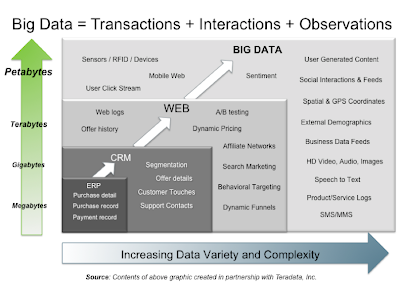I attended the Goldman Sachs Cloud Conference and participated on a panel focused on “Data: The New Competitive Advantage”. The
panel covered a wide range of questions, but kicked off covering two basic
questions:
“What is Big Data?”
and “What are the drivers behind the Big
Data market?”
While most definitions of Big Data focus on the new forms of
unstructured data flowing through businesses with new levels of “volume,
velocity, variety, and complexity”, I tend to answer the question using a
simple equation:
Big Data = Transactions + Interactions + Observations
The following graphic illustrates what I mean:
ERP, SCM, CRM, and transactional Web applications are classic
examples of systems processing Transactions. And the highly structured data in
these systems is typically stored in SQL databases.
Interactions are about how people and things interact with
each other or with your business. Web Logs, User Click Streams, Social Interactions
& Feeds, and User-Generated Content are classic places to find Interaction
data.
Observational data tends to come from the “Internet of Things”. Sensors for heat, motion,
pressure and RFID and GPS chips within such things as mobile devices, ATM
machines, and even aircraft engines provide just some examples of “things” that
output Observation data.
With that basic definition of Big Data as background, let’s answer
the question:
What are the 7 Key Drivers Behind the Big Data Market?
Business
1.
Opportunity
to enable innovative new business models
2.
Potential for new insights that drive competitive advantage
Technical
3.
Data
collected and stored continues to grow exponentially
4.
Data is
increasingly everywhere and in many formats
5.
Traditional
solutions are failing under new requirements
Financial
6.
Cost of
data systems, as % of IT spend, continues to grow
7.
Cost
advantages of commodity hardware and open source software
There’s a new generation of data management technologies,
such as Apache Hadoop, that are providing an innovative and cost effective
foundation for the emerging landscape of Big Data processing and analytics
solutions. Needless to say, I’m excited to see how this market will mature and
grow over the coming years.
Key Takeaway
Being able to dovetail the classic world of Transactions
with the new(er) worlds of Interactions and Observations in ways that drives
more business, enhances productivity, or discovers new and lucrative business opportunities
is why Big Data is important.
One promise of Big Data is that companies who get good at
collecting, aggregating, refining, analyzing, and maximizing the value derived
from Transactions, Interactions, and Observations will put themselves in a position
to answer such questions as:
What are the behaviors that lead to the transaction?
And even more interestingly:
How can I better encourage those behaviors and grow my business?
So ask yourself, what’s your Big Data strategy?




No comments:
Post a Comment